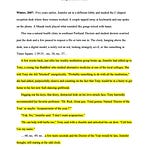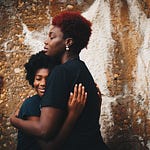Welcome:
We are at the final conversation of Flying Lesson 1, which takes all we’ve discussed and puts it into a wider, but also tighter perspective.
In Pt. 2 of this lesson, I redrew the arc for Show Me the Way into a series of circles that looked like this:

This chart was born from two sources: 1) chiasm, and 2) the three levels of conflict from Story by Robert McKee (which I’ll share in a moment). But chiasm first.
Chiasm:
Chiasm is a traditional literary form, but the design principle is equally applicable in music and the visual arts. It consists of paired events arranged symmetrically around a center core. The simplest form is B, A, B, with A representing the center and B the symmetrical rings. The next more complicated level is C, B, A, B, C, and the sequence continues on from there. You can see the basic pattern; it’s essentially a stone thrown into a pond with concentric circles fanning out around it.
~ Eye of the Heart by Cynthia Bourgeault
I learned about chiasm over the summer while taking a retreat with Bourgeault. It is a method for analyzing causality (cause and effect) I’d not considered before. Bourgeault explains chiasm in relation to biblical stories and Babette’s Feast by Izac Dinesen, which you can read if you are so inclined. But this is not going to be a full-blown lesson on chiasm. Rather I’d like to begin with what we can learn about memoir writing from the simple image of chiasm, that of a stone thrown into a pond with concentric circles fanning out around it. That is what I’d like to build on.
For a memoir writer, this image of chiasm is particularly poignant because our core wound is always the center of our story (whether we write this way or not, we are, conscious or not, informed by our wounds). For example: The core wound in Show Me the Way was the abandonment by the mother. From that center, everything else reverberated outward.
If you are piqued at all by this, you’ll be asking: What is my core wound from which everything else reverberates?
Good. That’s the question I want you to ask, but don’t stop there. Like the concentric circles fanning out, knowing your wound is the first part of this thing. Telling the story is the next. You tell your story to one person, just one, and you change, as do they. It’s called therapy. When you write that story, it is another outward layer of movement. That’s why writing one’s story is used as a therapeutic device by experts treating trauma and PTSD. When you read your story to an audience of people (or they read your story in a book or article or here, on Substack), the ripples go out further still.
As a side note, I have to wonder how much my own healing was advanced by the success of Blackbird, a book that took me around the world, had me sitting on stages with Oprah and Rosie O’Donnell, and receiving letters from people who in turn asked their own healing.
Now, let’s go a step further: What if you read your work (or your work was read by those who participated in injuring you and they listened? What then?
Meredith Hall, who wrote a memoir about family and community betrayal and having to surrender her son, did a version of this. When she sat down to write her memoir, she imagined a group of people from her community as her audience.
Family. Church. School. Community. There are not many ways you can get kicked out of those memberships. As a child in Hampton, New Hampshire, I knew husbands who cheated on their wives. Openly. My father. I knew men and women who beat their children. We all knew them. We all knew men who were too lazy to bring in a paycheck or clean the leaves out of their yards, women who spent the day on the couch crying while the kids ran loose with the neighborhood. We knew who drank at the Meadowbrook after work each day and drove home to burn SpaghettiOs on the stove for the children. We even knew a witch. We called her Goody Welsh, as if her magic had kept her alive since the Salem days. But this was 1965. All these people were tolerated. More than tolerated. They were the community. The teachers and ministers’ wives and football players and drugstore owners. They lived next to me on Leavitt Road and Mill Road and High Street. They smiled hello when I rode my bike past their clean or dirty yards, their sunny or shuttered houses.
Then I got pregnant. I was sixteen. Family, church, school—each of these memberships that had embraced me as a child—turned their backs.
~ Meredith Hall, Without a Map
What impact did this visualization exercise have on Hall’s personal journey of healing? How many ripples did she create, reverberating outwardly but also inwardly?
Paid subscribers, read on with my thanks.
Everyone else, might you consider becoming paid? For the price of a latte, you’ll enjoy this entire post, be part of a terrific community, get discounts, and more! Thanks. 🤗
Listen to this episode with a 7-day free trial
Subscribe to Flight School with Jennifer Lauck to listen to this post and get 7 days of free access to the full post archives.














